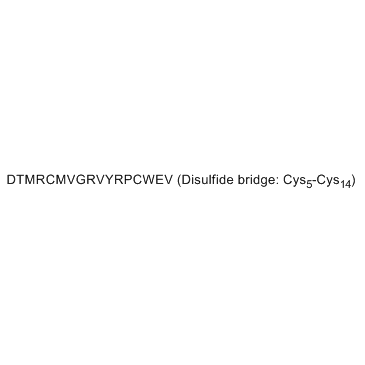| Description |
Melanin Concentrating Hormone, salmon is a 19-amino-acid neuropeptide initially identified in the pituitary gland of teleost fish, which regulates food intake, energy balance, sleep state, and the cardiovascular system. Melanin-concentrating hormone is a ligand for an orphan G protein-coupled receptor (SLC-1/GPR24) and MCHR2.
|
| Related Catalog |
|
| Target |
SLC-1/GPR24, MCHR2[1]
|
| In Vitro |
An orphan G protein-coupled receptor (SLC-1/GPR24) has been identified as a receptor for MCH (MCHR1). MCHR2 has higher protein sequence homology to MCHR1 than any other G protein-coupled receptor. MCHR2 is specifically activated by nanomolar concentrations of MCH, binds to MCH with high affinity, and signals through Gq protein[1].
|
| In Vivo |
Melanin Concentrating Hormone stimulates appetite. Continuous infusion of Melanin Concentrating Hormone into the ventricular system increases food intake for 7-8 days[2]. Intracerebroventricular infusion of Melanin Concentrating Hormone (10 μg/day) causes a slight but significant increase in body weight in mice maintained on the regular diet. Chronic stimulation of the brain Melanin Concentrating Hormone system could cause obesity in mice[3].
|
| Kinase Assay |
Binding of 125I-labeled Melanin Concentrating Hormone (MCH) to MCHR1 and MCHR2 is measured by filtration binding assay. Membranes (10 μg protein) from transiently transfected HEK293-MCHR1 and HEK293-MCHR2 cells are mixed with 0-9.8 nM 125I-labeled MCH in the binding buffer (50 mM Hepes/10 mM MgCl内容2/2 mM EGTA; protease inhibitors, 0.1% BSA, pH 7.6). After incubation for 1 h at room temperature, membrane-bound 125I-labeled MCH is separated from the free 125I-labeled MCH by filtration through a 96-well GF/B plate on a Packard Filtermate Cell Harvester and ished with ice-cold binding buffer supplemented with 80 mM NaCl. Eighty microliters of scintillation liquid is added, and the radioactivity is counted on a Packard Microplate Topcount[1].
|
| Animal Admin |
Rats[2] Both male Wistar and male Sprague-Dawley rats weighing between 310 and 370 g (age 8-11 weeks) are used in the study. All animals receive food which had the following dry weight composition: 64% carbohydrate, 22% protein, 4.3% fat, 4% cellulose and 5.5% ash. For chronic experiments, the rats are infused either with artificial CSF (0.5 μL/h) or MCH (8 μg/rat/day).Body weight and food intake are then recorded daily for 12 days[2]. Mice[3] Male C57BL/6J mice is prepared for measurement of spontaneous motor activity. Melanin Concentrating Hormone (10 μg/day) or the vehicle is infused for 14 days under the regular diet-fed condition. Motor activity is measured during the last 3 days of the 14-day infusion by an activity monitoring system in home cages[3].
|
| References |
[1]. An S, et al. Identification and characterization of a melanin-concentrating hormone receptor. Proc Natl Acad Sci U S A. 2001 Jun 19;98(13):7576-81. [2]. Della-Zuana O, et al. Acute and chronic administration of melanin-concentrating hormone enhances food intake and body weight in Wistar and Sprague-Dawley rats. Int J Obes Relat Metab Disord. 2002 Oct;26(10):1289-95. [3]. Gomori A, et al. Chronic intracerebroventricular infusion of MCH causes obesity in mice. Melanin-concentrating hormone. Am J Physiol Endocrinol Metab. 2003 Mar;284(3):E583-8. Epub 2002 Nov 26.
|
